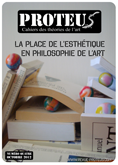Esthétique et effectivité de la pensée : à propos du spectateur d’art chez Rancière
Abstract
 Télécharger l’article
Télécharger l’article
Paru dans : Proteus n°4

Dans cet article, nous essayerons de repenser le rôle ambigu de l’expérience esthétique au cœur du conflit entre les œuvres théoriques de Michael Fried et de Joseph Kosuth (à bien des égards, suites historiques des propositions de Greenberg et de Judd). Nous voulons montrer que ces deux positions partagent, à leur insu, une même notion de sujet de l’expérience artistique. Tous deux partent en effet d’un même constat polémique : la passivité inhérente de la position du spectateur. Pour montrer les limites de ce postulat, nous ferons appel à la notion de « spectateur émancipé » de Jacques Rancière.
Mots-clés : geste formel — Franck Stella — abstraction américaine — modernité/postmodernité — efficacité de l’art
In this paper, we will try to rethink the ambiguous role of the aesthetic experience at the heart of the conflict between Michael Fried and Joseph Kosuth’s theoretical works (which to many aspects descend from Greenberg and Judd’s historical propositions). We hope to show that these two positions share, without their knowledge, a similar notion of subject of the aesthetic experience. Incidentally, both grow from a common controversial observation : the inherent passivity of the spectator’s position. To show the limits of this postulate, we will use the notion of « emancipated spectator » as developed by Jacques Rancière.
Keywords : formal action — Franck Stella — American abstraction– modernity/postmodernity — efficacy of art








